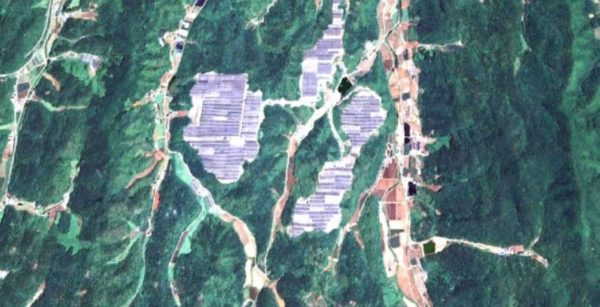Researchers from the Korea Maritime Institute have proposed the use of solar trees to build photovoltaic plants in mountainous forest areas in land-scarce South Korea.
They defined the new concept as forest-photovoltaic and explained that it would both maintain carbon absorption activities under the solar trees and produce solar power on the upper part of forest land.
“Compared to a general flat fixed panel, the solar tree has a higher structure and a stronger support base, increasing construction costs,” they explained. “As the demand for solar trees increases due to the development of new technology, more companies enter the market. Therefore, it is expected that solar trees can be installed at a cost that can compete with the current flat fixed panel in the not-too-distant future.”
Using Google Earth satellite imagery, the Korean group assessed the concept's operational potential by simulating solar tree installations in a mountainous area at 400 meters above sea level, where there is an operating agrivoltaic plant relying on solar trackers. “The solar power plant was constructed by cutting a mountainous ridge available in the highly elevated plateau into flat land,” they explained. “The solar panels installed on the 3-meter-high structure made a space for farming in the ground. One kind of ginseng, mountain garlic, is being grown in the space at the bottom of solar power facilities.”
The academics used Google Earth 3D to reflect solar tree size and the distance between the trees. As a reference, they considered a 4.8 m × 4.1 m panel with a rated power of 1.2 kW developed by Korea-based module manufacturer Hanwha Q Cells. “The slope distance was measured using the built-in elevation path measurement function in Google Earth Pro to arrange the solar tree at 100 m intervals in the three-dimensional image,” they specified. “The forest area, solar panel, and open space were calculated using the polygon measurement function provided by Google Earth Pro to quantitatively evaluate changes in mountain landscape before and after solar tree installation.”

Image: Korea Maritime Institute, scientific reports, Creative Commons License CC BY 4.0
The researchers performed their analysis with criteria developed by Germany's Fraunhofer Institute for Solar Energy Systems (ISE) for agrivoltaic projects. One of the important factors they considered is the distance between the solar trees, which is crucial for determining their impact on the surrounding natural environment. They ascertained that, if the trees are installed according to the scale of the 3D image, a considerable number of solar trees could be deployed throughout the 1,100,872-square-meter study area. If too many solar trees are placed in a limited space, however, the solar trees displayed as too small in size, causing significant limitations in terms of visual effect, they noted.
Despite their higher costs compared to conventional PV installations, solar trees may have a strategic advantage as they occupy a much lower amount of land. “The land purchase cost is the most important parameter in calculating LCOE on the solar power plant in South Korea,” the research team said. “Compared to other countries, South Korea ranks third in the world in terms of land price. So, purchasing the land is much higher than the money required to build a solar power plant.” On the other hand, in the South Korean Energy Agency's most recent renewables auction, the final average price was KRW 143.120 per kWh ($0.11), which shows prices quite above the average prices seen in the world's largest and most mature solar markets.
“The solar tree has not been popularized yet, so the forest-photovoltaic field has many problems to be solved and is only in its infancy,” the scientists admitted, noting that most major module manufacturers haven't entered the business yet. “The procedure for the solar tree to be commercialized has to deal with different international standardization and regulation schemes.”
They introduced their concept in the study “Exploring the operational potential of the forest-photovoltaic utilizing the simulated solar tree,” published in scientific reports. “A follow-up study is needed to initiate legally binding international standards for solar trees' wind and snow load operation,” they concluded.
This content is protected by copyright and may not be reused. If you want to cooperate with us and would like to reuse some of our content, please contact: editors@pv-magazine.com.




2 comments
By submitting this form you agree to pv magazine using your data for the purposes of publishing your comment.
Your personal data will only be disclosed or otherwise transmitted to third parties for the purposes of spam filtering or if this is necessary for technical maintenance of the website. Any other transfer to third parties will not take place unless this is justified on the basis of applicable data protection regulations or if pv magazine is legally obliged to do so.
You may revoke this consent at any time with effect for the future, in which case your personal data will be deleted immediately. Otherwise, your data will be deleted if pv magazine has processed your request or the purpose of data storage is fulfilled.
Further information on data privacy can be found in our Data Protection Policy.